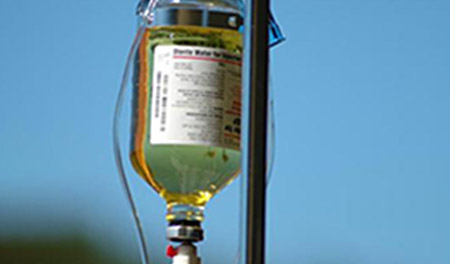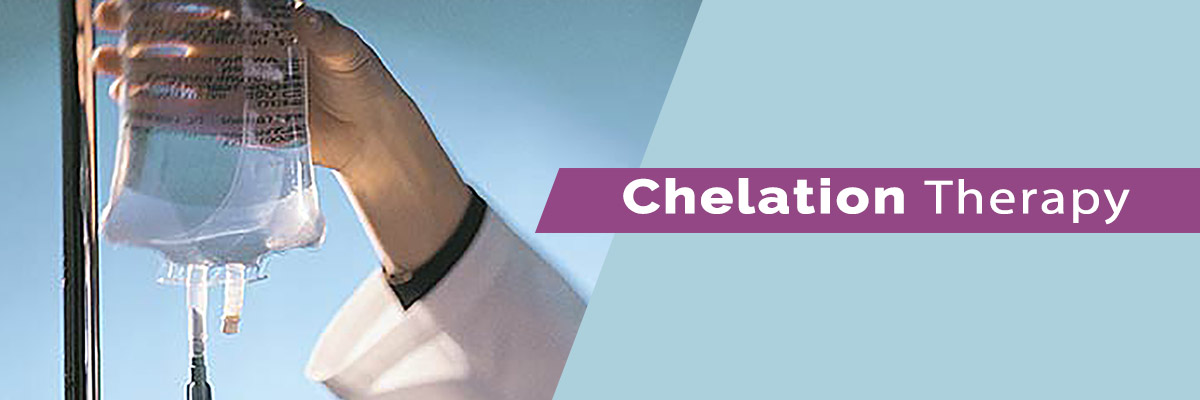
Chelation Therapy Centre
The word Chelation is derived from the Greek word chele, which means ‘to claw’. The concept of chelation is based on the binding of positively charged heavy metals by an amino acid complex, EDTA, in a manner similar to the clawing action of a scorpion or a crab. Most commonly used chelator at our center is EDTA. Chelation Therapy treatment is a process of removal of toxic heavy metals from the body by the intravenous (IV) infusion of an organic compound with appropriate chelating properties.
The most widely accepted use of chelation therapy in medicine is for the removal of toxic metals, such as lead, arsenic, cadmium, mercury, iron, copper or aluminum from the body. Another useful indication for chelation therapy is the treatment of all forms of atherosclerotic diseases, including, coronary, cerebral, and peripheral arterial disease as well as other degenerative conditions.
Chelating Agents
chelating agents are Certain organic compounds capable of forming coordinate bonds (see chemical bond) with metals through two or more atoms of the organic compound; such organic compounds are called chelating agents.
- Hydrophilic chelators most effectively promote renal metal excretion, but they complex intracellular metal deposits inefficiently
- Lipophilic chelators can decrease intracellular stores but may redistribute toxic metals too, for example, the brain. In chronic metal-induced disease, where life-long chelation may be necessary, possible toxicity or side effects of the administered chelator may be limiting.
- Natural chelators: water, carbohydrates, including polysaccharides, organic acids with more than one, coordination group, lipids, steroids, amino acids, and related compounds, peptides, phosphates, nucleotides, tetrapyrroles, ferrioxamines, ionophores, such as gramicidin, monensin, valinomycin, phenolics etc. Chlorella, Activated charcoal, Cilantro being the natural chelators
- Synthetic chelators: BAL, deferoxamine, deferiprone, DMPS, DMSA, D-penicillamine, DTPA, EDTA, tetrathiomolybdate, Prussian blue, etc.
How Chelation Therapy Works !!
The aim of chelation is to relieve the body of toxic metals. Chelated toxic metals need to be eliminated, usually via urine, occasionally also by the bile and stool. EDTA and other chelating drugs lower the blood levels of metals such as lead, mercury, cadmium, and zinc by attaching to the heavy metal molecules, which helps the body remove them through urination. Chelation therapy benefits the flow of blood through every vessel in the body, from the largest to the tiniest capillaries and arterioles, Chelation halts the progress of the free radical disease.

Free radicals underlie the development of atherosclerosis and many other degenerative diseases of aging. when the results were statistically analyzed. Most importantly, cardiovascular surgery does nothing to arrest or reverse the underlying disease, which exists in varying degrees throughout the body. It is at best a piecemeal “cure” for a system-wide problem. chelation therapy will help reopen arteries blocked by mineral deposits, a condition called atherosclerosis(calcium being the binding material in plaque) or hardening of the arteries.
It has been proven to be very effective and a less expensive alternative to coronary bypass surgery, angioplasty, and other techniques designed to unclog blocked arteries. Due to the low risk and zero surgery, chelation treatments are now being considered as primary care.

Heavy Metal Toxicity
What is Heavy Metal Toxicity?
The presence of excessive amounts of toxic metals in the body contributes to health problems, which can be directly linked to the metal itself as well as the toxic load stressing the immune system. We live in a world that can be described as a toxic soup.
Never before has a society been so constantly exposed to such a wide array of potentially hazardous substances permeating every aspect of the environment. This exposure begins in utero and continues throughout life. Many people who are seemingly healthy also have build-ups that can, with time, contribute to the development of health problems. Many children, including those diagnosed within the autistic spectrum disorder, also are affected by metals
Heavy metals disrupt the metabolic functions in 2 ways:
- Accumulation and thereby disrupting the function of vital organs and glands like the heart, brain, kidney, bone, liver etc..
- Knockoff essential elements in the enzyme reaction, thereby critically disrupt enzyme activity also cause free radical proliferation. These toxins are absorbed through foods, beverages, skin, air, water, cosmetics etc.
- Co, Cu, Fe, Mn, Mo, Se, Zn etc. are essential in trace amounts.
- Nonessential harmful heavy metals are Cd, Sb, Cr, Hg, Pb, As.
TOXIC METALS- EFFECTS ON HEALTH
Alluminum:-
Sources:- Antacids, Preservatives, Antiperspirants, Toothpaste
Affinity:- Brain, Bone
Diseases:- Alzheimer’s, Vitamin D Resistant Osteomalacia, ALS, Hypochromic anemia, Dialysis encephalopathy.
Antimony:-
Sources:– Paints, Ceramics, Enamel, Alloys, Electronics, Rubber.
Affinity:- Lymph nodes, Adrenals, Lungs, Skin.
Diseases:- Uremic patients, Injured Heart tissue, Bilharziasis, Schistosomiasis.
Arsenic:-
Sources:- Tobacco smoke, In earth crust
Affinity:– Liver, Lung, Bladder, Kidney, Skin
Diseases:- As a tumor promoter, Lung cancer, Skin cancer, Vitiligo, Alopecia totalis
Cadmium:-
Sources:- Paints, Battery, Car exhaust, Industrial fumes, Polluted water, Tobacco smoke.
Affinity:– Liver, Bones
Diseases:– Hyperactivity in children, Renal disease, Hypertension, Prostate cancer, Cancer of Lungs, kidney, pancreas, testes, uterus, breast, gallbladder
Lead:-
Sources:– Canned goods, Lead paint, Newsprint, Tobacco smoke, Air pollution, and Contaminated water.
Affinity:– Kidney, Brain, Lung, Stomach
Diseases:– Carcinomas, Encephalopathy, psychoneurosis, joint pains
Manganese:-
Sources:– In pharmaceutical products, In disinfectants, pesticides, In food additives, In fertilizers, In groundwater.
Affinity:– Liver, Kidney, Pineal/pituitary gland, pancreas
Diseases:– Parkinson’s disease, Bulbar paralysis, Multiple sclerosis, Wilsons disease, Acute/Chronic bronchitis, Pneumonia, Spontaneous miscarriages, iron deficiency anemia.
Mercury:-
Sources:- Dental amalgam is a major source, Many children vaccines, paints, Bleaches, Explosives, Batteries, Fungicides, Cosmetics, Dyes, Petroleum products, Contaminated see foods,
Affinity:- Brain
Chromium:-
Sources:– Dyes, Paints, In soil and groundwater at abandoned industrial sites, Aerospace, and automobile refinishing applications
Affinity:- RBC, Kidney, Liver, Spleen, Bone, Alters DNA
Diseases:- Housewife Eczema, Acute renal failure, Genotoxicity
Nickel:-
Sources:– Cigarette smoke, Coins, For plating iron, brass..etc
Affinity:– Lung Connective tissue
Diseases:– Strokes, Toxaemia, Lung Cancer, Nasal cavity cancer, Eczema, Vitiligo
Heavy metals disrupt the metabolic functions in 2 ways:
- Accumulation and thereby disrupting the function of vital organs and glands like heart, brain, kidney, bone, liver etc.. Knockoff essential elements in the enzyme reaction, thereby critically disrupt enzyme activity also cause free radical proliferation. These toxins are absorbed through foods, beverages, skin, air, water, cosmetics etc
- Co, Cu, Fe, Mn, Mo, Se, Zn etc. are essential in trace amounts. Non-essential harmful heavy metals are Cd, Sb, Cr, Hg, Pb, As.
Toxic metals are taken very seriously in alternative medicine. Testing and treating for them is as important as optimum nutritional intake and a healthy lifestyle.
, when the results were statistically analyzed. Most importantly, cardiovascular surgery does nothing to arrest or reverse the underlying disease, which exists in varying degrees throughout the body. It is at best a piecemeal “cure” for a system-wide problem.
Chelation patients are frequently able to return to work and to resume their sports and other activities, without the need to undergo surgery. If they stay on a proper diet, exercise within limits of tolerance, continue to take the prescribed program of nutritional supplements, and receive periodic maintenance chelation treatments (every one to two months, depending on the severity of the underlying medical diagnosis) they can usually go many years without suffering further heart attacks, strokes, senility or gangrenous extremities.
Because the very aging process itself correlates with ongoing free radical damage, it is no surprise that a large variety of symptoms have been reported to improve following chelation therapy. symptoms of arthritis, Alzheimer’s, Parkinson ’s, psoriasis, high blood pressure, and scleroderma have all been reported to improve with chelation therapy. In fact, there is no better treatment for scleroderma.
Vision has been improved in macular degeneration. Patients generally feel younger and more energetic following therapy, even when taken for purely preventive reasons. In fact, chelation therapy is more desirable for prevention that it is for established disease. Preventive medicine is always preferable to late-stage crisis intervention.
Patients who received EDTA chelation therapy had a 90% reduction of cancer deaths. There is a large body of scientific research indicating that free radical damage to DNA is an important factor at the onset of most cancer. Chelation therapy blocks damaging free radicals.
Chelation therapy is now being trialed for alternative treatment for many wide-ranging conditions, such as gangrene, thyroid disorders, multiple sclerosis, muscular dystrophy, psoriasis, diabetes, arthritis, Alzheimer’s disease, and the improvement of memory, sight, hearing, and smell. Each set of treatments is designed to target a focused set of toxins. In this way, the balance of the bodies necessary chemicals are preserved.




